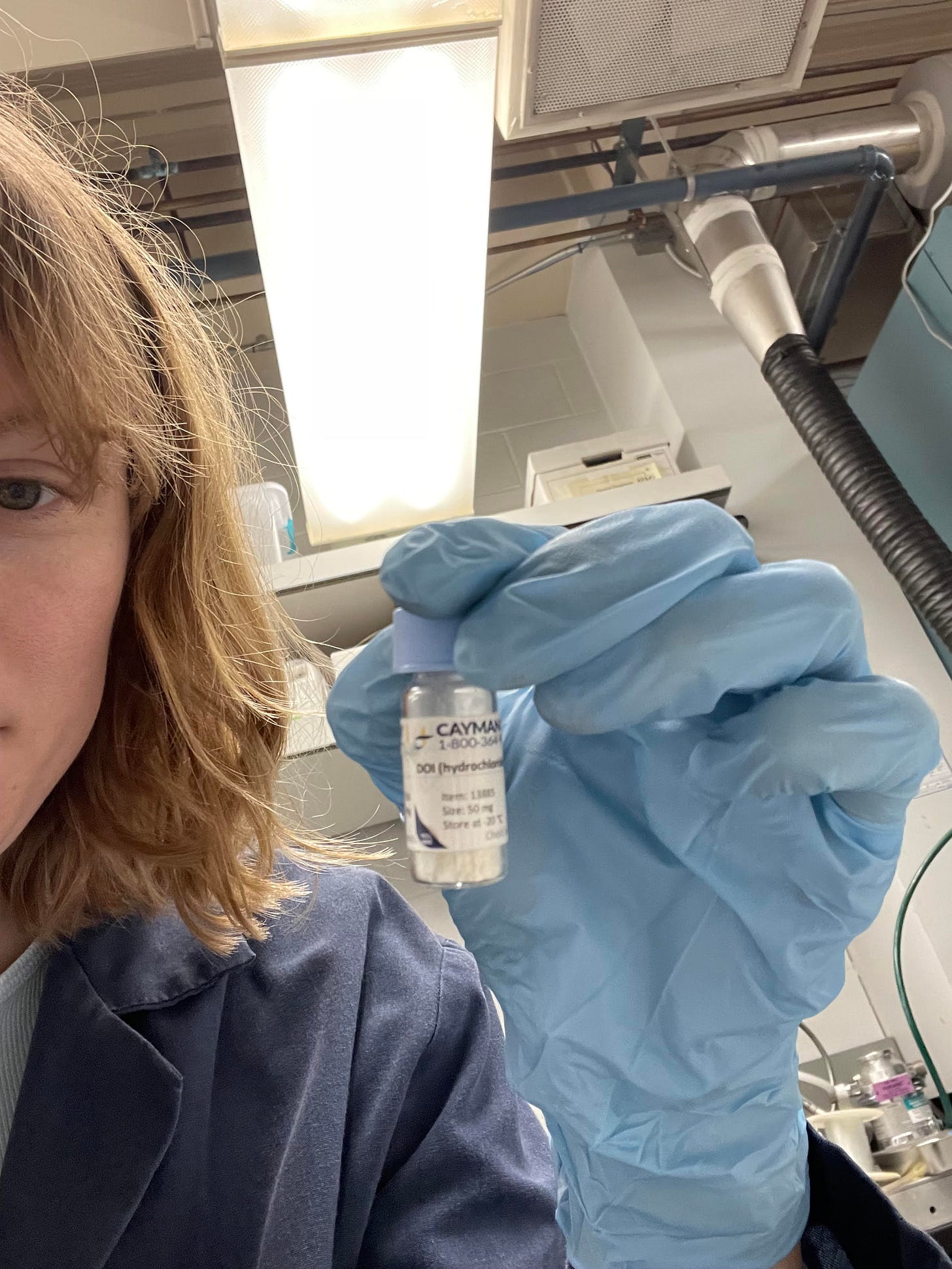An undergrad, twitching rodent heads, DOI, and the DEA: 5 Questions for researcher Alyssa Gillies
Gillies discusses how she uses DOI in the lab and what rescheduling would mean for psychedelic research.
In December, the U.S. Drug Enforcement Administration posted a new document on the Federal Register in which the agency proposed that two previously unscheduled hallucinogens, 2,5-dimethoxy-4-iodoamphetamine (known as DOI) and 2,5-dimethoxy-4-chloroamphetamine (known as DOC), be added to the list of Schedule I drugs. This is the classification the DEA gives to drugs including LSD and heroin that it finds to have “no currently accepted medical use and a high potential for abuse.”
Researchers were surprised by the proposal: the DEA had tried to do the same thing back in April 2022, but quietly withdrew their plan after pushback from psychedelic activists, researchers, and companies. DOI and DOC are commonly used in research to study how psychedelics work in the brain through what's called the serotonin 5-HT2 receptor. It is difficult for researchers to get access to Schedule 1 substances and DOI and DOC have served as accessible hallucinogens for scientific study. Often, the people actually administering these drugs to rodents and other animals in the lab are undergraduate researchers like Alyssa Gillies, a third year molecular synthesis major at the University of California at San Diego. Gillies works in the lab of neurobiologist and professor Adam Halberstadt; she was among the 150 people who submitted public comment to the DEA about the agency’s proposal to make DOI a Schedule 1 drug. The Microdose spoke with Gillies about how she uses DOI and what rescheduling would mean for the lab’s research.
How are you using DOI in the lab?
I’ve been working on psychedelic research, and one indicator we look at is what’s called the head twitch response. If you give a rodent a psychedelic, they’ll have an involuntary head twitch response, which has also been called, colloquially, a wet dog shake. It’s a response to their 5-HT2A receptors being activated. In the studies I’m conducting, we study how many twitch responses a rodent produces over a period of between 30 minutes to one hour.
This work explores the mechanistic component of the 5-HT2 receptor. DOI is often used as a standard in this kind of work, mostly because it’s not scheduled and is therefore very accessible; you can compare rodents’ head twitch response to DOI with their responses to other drugs, especially novel psychedelic compounds. So what I do is inject mice with DOI and put them in a chamber designed to measure their head twitch responses, and that data can be used as a baseline for comparison to other drugs. I know there are also researchers at Louisiana State University looking at how drugs that act on the 5-HT2 receptor, like DOI, might produce an anti-inflammatory response in rodents.
How would scheduling DOI affect the work you and your colleagues are doing in the lab?
If DOI were a Schedule I drug, it would be a real barrier to any lab studying the 5-HT2 receptor. As is, you don’t need a Schedule I license to access it. If it were scheduled, it’d be less accessible to many labs, especially if they didn’t already have that license. Applying for a license would require additional paperwork and delays. In the Federal Register, the DEA highlighted nine additional requirements that labs would need to take to work with drugs, like registering researchers, taking inventory and reporting it to the DEA, and storing and handling the drugs.
What protocols are there currently around using DOI in the lab and how do they compare with the rules for other psychedelics?
If I’m using a Schedule I drug, I have to go to either the lab’s Principal Investigator, or P.I., or to the lab manager and ask them if they can access the secure location where those drugs are kept – they’re the only ones with the key to the safe. If those people are not around, that becomes an issue, and there have been times when our experiments were delayed as a result of those key people being out.
The DEA proposal points to DOI and DOC’s abuse potential as justification for its scheduling proposal. What do you know about whether people are actually using these drugs recreationally outside of a research setting?
Here’s the thing: pretty much nobody is using DOI as a recreational drug because its duration is really long. For comparison, LSD lasts 8 to 12 hours in humans; DOI can last up to 24 hours. If you look in the Federal Register, they cite a report that said globally, there were 16 instances of non-fatal intoxication from DOC over 9 years, which means fewer than 2 people a year are using doses. It’s just absurd; they’re going after these compounds that are clearly not being used recreationally.
How have your colleagues reacted to this DEA proposal?
There are a lot of people who are pretty upset about it. The general feeling amongst researchers is that the new proposal is absurd; ultimately, it would only impact us, and the progress of psychedelic-related research. By trying to schedule these drugs, the DEA is also claiming that none of these compounds have approved medical utility, but that’s not necessarily true, and scheduling DOI and DOC will make it that much harder to study them.
This interview has been edited and condensed for clarity and length.







